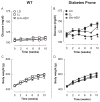Disruption of circadian rhythms accelerates development of diabetes through pancreatic beta-cell loss and dysfunction
- PMID: 21921296
- PMCID: PMC3359760
- DOI: 10.1177/0748730411416341
Disruption of circadian rhythms accelerates development of diabetes through pancreatic beta-cell loss and dysfunction
Abstract
Type 2 diabetes mellitus (T2DM) is complex metabolic disease that arises as a consequence of interactions between genetic predisposition and environmental triggers. One recently described environmental trigger associated with development of T2DM is disturbance of circadian rhythms due to shift work, sleep loss, or nocturnal lifestyle. However, the underlying mechanisms behind this association are largely unknown. To address this, the authors examined the metabolic and physiological consequences of experimentally controlled circadian rhythm disruption in wild-type (WT) Sprague Dawley and diabetes-prone human islet amyloid polypeptide transgenic (HIP) rats: a validated model of T2DM. WT and HIP rats at 3 months of age were exposed to 10 weeks of either a normal light regimen (LD: 12:12-h light/dark) or experimental disruption in the light-dark cycle produced by either (1) 6-h advance of the light cycle every 3 days or (2) constant light protocol. Subsequently, blood glucose control, beta-cell function, beta-cell mass, turnover, and insulin sensitivity were examined. In WT rats, 10 weeks of experimental disruption of circadian rhythms failed to significantly alter fasting blood glucose levels, glucose-stimulated insulin secretion, beta-cell mass/turnover, or insulin sensitivity. In contrast, experimental disruption of circadian rhythms in diabetes-prone HIP rats led to accelerated development of diabetes. The mechanism subserving early-onset diabetes was due to accelerated loss of beta-cell function and loss of beta-cell mass attributed to increases in beta-cell apoptosis. Disruption of circadian rhythms may increase the risk of T2DM by accelerating the loss of beta-cell function and mass characteristic in T2DM.
© 2011 The Author(s)
Conflict of interest statement
The author(s) have no potential conflicts of interest with respect to the research, authorship, and/or publication of this article.
Figures






References
-
- Bouatia-Naji N, Bonnefond A, Cavalcanti-Proenca C, Sparso T, Holmkvist J, Marchand M, Delplanque J, Lobbens S, Rocheleau G, Durand E, et al. A variant near MTNR1B is associated with increased fasting plasma glucose levels and type 2 diabetes risk. Nat Genet. 2009;41:89–94. - PubMed
-
- Butler AE, Jang J, Gurlo T, Carty MD, Soeller WC, Butler PC. Diabetes due to a progressive defect in beta-cell mass in rats transgenic for human islet amyloid polypeptide (HIP rat): A new model for type 2 diabetes. Diabetes. 2004;53:1509–1516. - PubMed
-
- Butler AE, Janson J, Bonner-Weir S, Ritzel R, Rizza RA, Butler PC. Beta-cell deficit and increased beta-cell apoptosis in humans with type 2 diabetes. Diabetes. 2003;52:102–110. - PubMed
Publication types
MeSH terms
Substances
Grants and funding
LinkOut - more resources
Full Text Sources
Other Literature Sources
Medical
Research Materials

